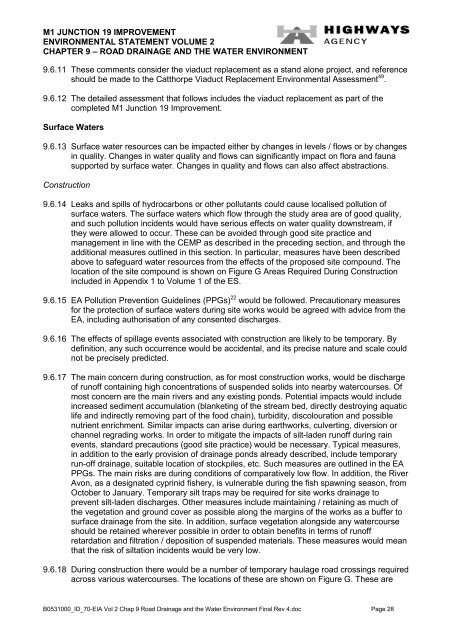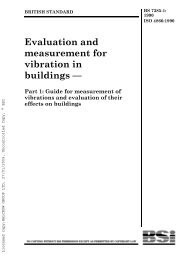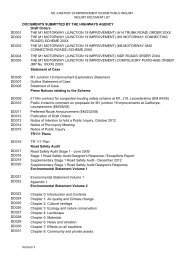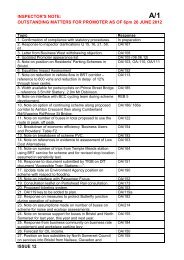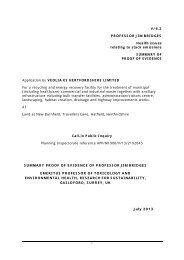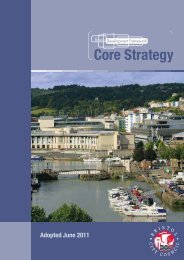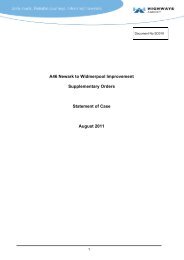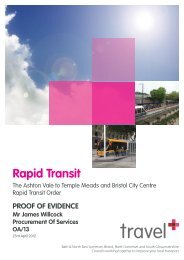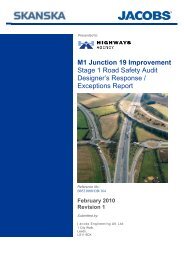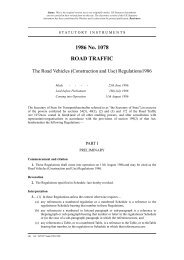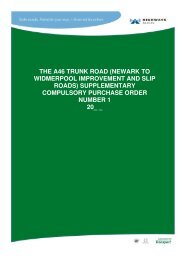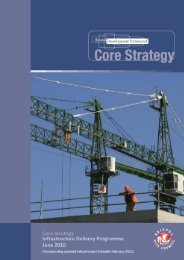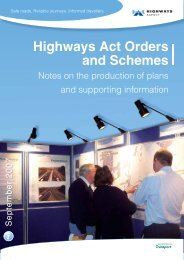Chapter 9: Road drainage and the water environment
Chapter 9: Road drainage and the water environment
Chapter 9: Road drainage and the water environment
You also want an ePaper? Increase the reach of your titles
YUMPU automatically turns print PDFs into web optimized ePapers that Google loves.
M1 JUNCTION 19 IMPROVEMENT<br />
ENVIRONMENTAL STATEMENT VOLUME 2<br />
CHAPTER 9 – ROAD DRAINAGE AND THE WATER ENVIRONMENT<br />
9.6.11 These comments consider <strong>the</strong> viaduct replacement as a st<strong>and</strong> alone project, <strong>and</strong> reference<br />
should be made to <strong>the</strong> Catthorpe Viaduct Replacement Environmental Assessment 49 .<br />
9.6.12 The detailed assessment that follows includes <strong>the</strong> viaduct replacement as part of <strong>the</strong><br />
completed M1 Junction 19 Improvement.<br />
Surface Waters<br />
9.6.13 Surface <strong>water</strong> resources can be impacted ei<strong>the</strong>r by changes in levels / flows or by changes<br />
in quality. Changes in <strong>water</strong> quality <strong>and</strong> flows can significantly impact on flora <strong>and</strong> fauna<br />
supported by surface <strong>water</strong>. Changes in quality <strong>and</strong> flows can also affect abstractions.<br />
Construction<br />
9.6.14 Leaks <strong>and</strong> spills of hydrocarbons or o<strong>the</strong>r pollutants could cause localised pollution of<br />
surface <strong>water</strong>s. The surface <strong>water</strong>s which flow through <strong>the</strong> study area are of good quality,<br />
<strong>and</strong> such pollution incidents would have serious effects on <strong>water</strong> quality downstream, if<br />
<strong>the</strong>y were allowed to occur. These can be avoided through good site practice <strong>and</strong><br />
management in line with <strong>the</strong> CEMP as described in <strong>the</strong> preceding section, <strong>and</strong> through <strong>the</strong><br />
additional measures outlined in this section. In particular, measures have been described<br />
above to safeguard <strong>water</strong> resources from <strong>the</strong> effects of <strong>the</strong> proposed site compound. The<br />
location of <strong>the</strong> site compound is shown on Figure G Areas Required During Construction<br />
included in Appendix 1 to Volume 1 of <strong>the</strong> ES.<br />
9.6.15 EA Pollution Prevention Guidelines (PPGs) 22 would be followed. Precautionary measures<br />
for <strong>the</strong> protection of surface <strong>water</strong>s during site works would be agreed with advice from <strong>the</strong><br />
EA, including authorisation of any consented discharges.<br />
9.6.16 The effects of spillage events associated with construction are likely to be temporary. By<br />
definition, any such occurrence would be accidental, <strong>and</strong> its precise nature <strong>and</strong> scale could<br />
not be precisely predicted.<br />
9.6.17 The main concern during construction, as for most construction works, would be discharge<br />
of runoff containing high concentrations of suspended solids into nearby <strong>water</strong>courses. Of<br />
most concern are <strong>the</strong> main rivers <strong>and</strong> any existing ponds. Potential impacts would include<br />
increased sediment accumulation (blanketing of <strong>the</strong> stream bed, directly destroying aquatic<br />
life <strong>and</strong> indirectly removing part of <strong>the</strong> food chain), turbidity, discolouration <strong>and</strong> possible<br />
nutrient enrichment. Similar impacts can arise during earthworks, culverting, diversion or<br />
channel regrading works. In order to mitigate <strong>the</strong> impacts of silt-laden runoff during rain<br />
events, st<strong>and</strong>ard precautions (good site practice) would be necessary. Typical measures,<br />
in addition to <strong>the</strong> early provision of <strong>drainage</strong> ponds already described, include temporary<br />
run-off <strong>drainage</strong>, suitable location of stockpiles, etc. Such measures are outlined in <strong>the</strong> EA<br />
PPGs. The main risks are during conditions of comparatively low flow. In addition, <strong>the</strong> River<br />
Avon, as a designated cyprinid fishery, is vulnerable during <strong>the</strong> fish spawning season, from<br />
October to January. Temporary silt traps may be required for site works <strong>drainage</strong> to<br />
prevent silt-laden discharges. O<strong>the</strong>r measures include maintaining / retaining as much of<br />
<strong>the</strong> vegetation <strong>and</strong> ground cover as possible along <strong>the</strong> margins of <strong>the</strong> works as a buffer to<br />
surface <strong>drainage</strong> from <strong>the</strong> site. In addition, surface vegetation alongside any <strong>water</strong>course<br />
should be retained wherever possible in order to obtain benefits in terms of runoff<br />
retardation <strong>and</strong> filtration / deposition of suspended materials. These measures would mean<br />
that <strong>the</strong> risk of siltation incidents would be very low.<br />
9.6.18 During construction <strong>the</strong>re would be a number of temporary haulage road crossings required<br />
across various <strong>water</strong>courses. The locations of <strong>the</strong>se are shown on Figure G. These are<br />
B0531000_ID_70-EIA Vol 2 Chap 9 <strong>Road</strong> Drainage <strong>and</strong> <strong>the</strong> Water Environment Final Rev 4.doc Page 28


